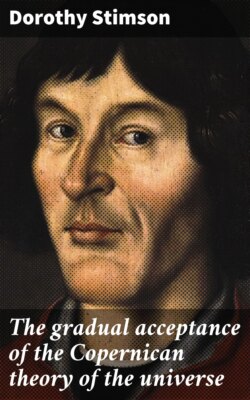The gradual acceptance of the Copernican theory of the universe

Реклама. ООО «ЛитРес», ИНН: 7719571260.
Оглавление
Dorothy Stimson. The gradual acceptance of the Copernican theory of the universe
The gradual acceptance of the Copernican theory of the universe
Table of Contents
PREFACE
PART ONE. AN HISTORICAL SKETCH OF THE HELIOCENTRIC. THEORY OF THE UNIVERSE
CHAPTER I. The Development of Astronomical Thought to 1400 A.D. A Preliminary Sketch of Early Theories as a Background
CHAPTER II. Copernicus and His Times
CHAPTER III. The Later Development and Scientific Defense. of the Copernican System
PART TWO. THE RECEPTION OF THE COPERNICAN THEORY
CHAPTER I. Opinions and Arguments in the Sixteenth Century
CHAPTER II. Bruno and Galileo
CHAPTER III. The Opposition and Their Arguments
CHAPTER IV. The Gradual Acceptance of the Copernican System
CHAPTER V. The Church and the New Astronomy: Conclusion
APPENDIX A. Ptolemy: Syntaxis Mathematica (Almagest)
APPENDIX B “To His Holiness, Paul III, Supreme Pontiff, Preface By Nicholas Copernicus to His Books on Revolutions.”
APPENDIX C
APPENDIX D. A Translation of a Letter by Thomas Feyens. On the Question: Is It True That the Heavens Are Moved and the Earth Is at Rest? (February, 1619)
BIBLIOGRAPHY (of references cited.)
I. General Works
II. Special Works
III. Sources
A: Pre-Copernican (chapters I and II)
B: Copernican and Post-Copernican
INDEX
Footnote
Отрывок из книги
Dorothy Stimson
Published by Good Press, 2021
.....
Popular interest in astronomy was evidently aroused, for Sacrobosco (to give John Holywood[31] his better known Latin name) a Scotch professor at the Sorbonne in Paris in the 13th century, published a small treatise De Sphæri Mundo that was immensely popular for centuries,[32] though it was practically only an abstract of the Almagest. Whewell[33] tells of a French poem of the time of Edward I entitled Ymage du Monde, which gave the Ptolemaic view and was illustrated in the manuscript in the University of Cambridge with a picture of the spherical earth with men upright on it at every point, dropping balls down perforations in the earth to illustrate the tendency of all things toward the center. Of the same period (13th century) is an Arabian compilation in which there is a reference to another work, the book of Hammarmunah the Old, stating that "the earth turns upon itself in the form of a circle, and that some are on top, the others below ... and there are countries in which it is constantly day or in which at least the night continues only some instants."[34] Apparently, however, such advanced views were of no influence, and the Ptolemaic theory remained unshaken down to the close of the 15th century.
Aside from the adequacy of this explanation of the universe for the times, the attitude of the Church Fathers on the matter was to a large degree responsible for this acquiescence. Early in the first century A.D., Philo Judæus[35] emphasized the minor importance of visible objects compared with intellectual matters,—a foundation stone in the Church's theory of an homocentric universe. Clement of Alexandria (c. 150 A.D.) calls the heavens solid since what is solid is capable of being perceived by the senses.[36] Origen (c. 185-c. 254.) has recourse to the Holy Scriptures to support his notion that the sun, moon, and stars are living beings obeying God's commands.[37] Then Lactantius thunders against those who discuss the universe as comparable to people discussing "the character of a city they have never seen, and whose name only they know." "Such matters cannot be found out by inquiry."[38] The existence of the antipodes and the rotundity of the earth are "marvelous fictions," and philosophers are "defending one absurd opinion by another"[39] when in explanation why bodies would not fall off a spherical earth, they claim these are borne to the center.
.....